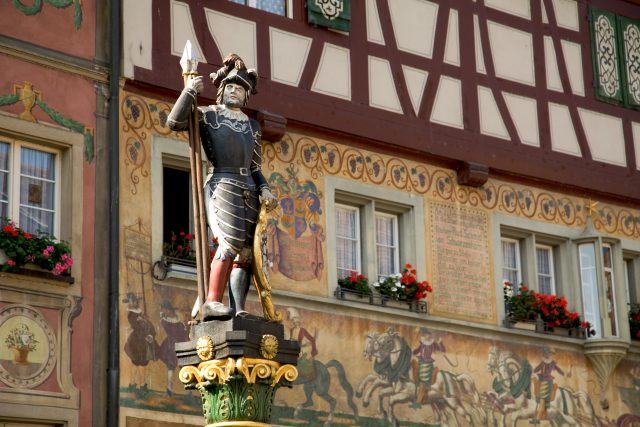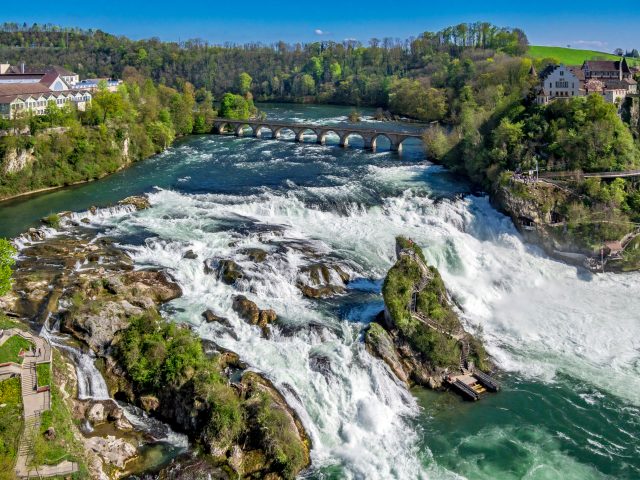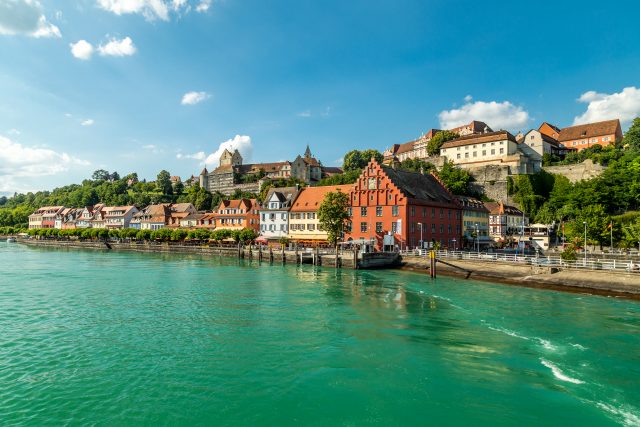Don’t just take our word for it. Headwater customer Mike Spiller writes about his recent cycling holiday to Lake Konstanz…
The Pfander cable-car station gives you stunning views of 3 countries. To the south are over 200 Swiss and Austrian Alpine mountain peaks. They stretch so far and wide that their beauty almost dilutes the sheer scale of the view. It would take months if not years to visit this amazing vista. But to the north and 670 metres below is Lake Konstanz. While the foreground shore is briefly Austrian, beyond to the left is Switzerland and to the right Germany. In between the Lake will be bustling with yachts, ferries and all manner of activity on the water, and, above, one may even see two airships. The Pfander panorama map shows where such towns as Romanshorn, Arbon, Konstanz and Friedrichshafen can be seen in the distance. This is even more impressive, if you have just spent the last 10 days cycling around the entire Lake through these towns and beyond, to such places such as Stein-am-Rhein and Reisnenau. A real sense of satisfaction, achievement – and enjoyment!

Headwater offers two options to cycle around Lake Konstanz, which is either 7 days without rest days, or 11 days with 4 rest days. The recorded route note distance is 200 kms, with a longest day of 59 kms. For the keen drop-handle cyclist where 60kms hardly warrants changing into lycra, then perhaps the gentler pace and amazing environment and scenery may not be their thing! But for those who prefer leisurely cycling, on a circuitous route with plenty of photo and water stops – or something stronger – then this is for you.
Two top tips for the trip. If you are going up a steep hill, you may be lost, and keep the Lake on your right-hand side. Across the Lake you can either see where you have been or where you are going to go. The Headwater notes are meticulously detailed and probably most needed when leaving one’s hotel to find the marked cycle route and then finding the hotel at the end of the day. My navigation focussed on 4 rules. Look for the signposts, the road markings or other cyclists. Rule 4 is if the other 3 have failed, stop and check!

You encounter the River Rhein twice, namely on Day 1 when it enters the Lake at the southern end and then at Stein-am-Rhein – the clue is in the town name – when it leaves the Lake and flows north. The Neu Rhein close to the Austrian/ Swiss border was straightened out around 1900 to carry the sediment further out into the Lake and reduce flooding in the surrounding area. This area is now very fertile farmland for both cattle and corn, pear and apple fruit farming. Watch the apples – those that drop on you, or the ones that your bike tyres slip on!
Overall the route nestles between the shore and the sloping hills, where farmland, roads, rail tracks, campsites, towns and villages all compete for the lake-side view. I lost count of the number of rail crossings I went over, including one created purely to allow access to one private house. The train offers an easy option if you want to shorten a day for whatever reason. So sometimes you are on the shore-side and at other times winding around houses or farmland.
The houses, old and new, all strive for that estate agent’s claim – with a lakeside view. For many of the new apartments it is often just one patio with a view, which are beautifully furnished. I saw one shop specialising solely in selling patio furniture. Further north vineyards became more prominent, especially as they stretch up the slopes. I was so tempted to “test” the grapes – they were that close!

One of the major urban centres on the route was the Swiss-German combination of Kreuslingen and Konstanz. The route initially keeps you in Switzerland and avoids three rather imposing German border crossings. We crossed 4 borders, not including criss-crossing the lake across the “loose” maritime border, and while carrying our passports, never showed them. Beyond Kreuslingen the Lake and the valley narrows, with the rail track, road and bike route all closely intertwined. There were some steeper slopes, slightly ill-timed in the latter part of the longest day’s cycling, but the route also took us through the main road of three charming old villages, Berlingen, Steckhorn and Mammern.
The holiday is managed on Headwater’s behalf by DONAU Touristik, whose distinctive bike panier bags were omni-present in the area. If you ask the DONAU staff who issue you the bikes, they will ferret away and find you their own English language version of the route, which combines route notes, maps and cultural information all in one booklet, which fits readily into the DONAU supplied handlebar bag. The one error I found in it was describing Stein-am-Rhein as “one of the most beautiful towns in Germany”. It is stunningly beautiful, but it is still in Switzerland!

To really appreciate the charm and history of the town’s main street you may need to get out early to avoid the many visitors. Look up. Every house front tells its own story in words and art work. I would divide the town into three, namely old town main street, old town back streets, and the modern town beyond the city walls. My favourite was the old town back streets, still beautiful but so peaceful, just yards from the main street. The dinner option was the Rheinfels Hotel, a historic old hotel nestled against the bridge, but with a stunning balcony witnessing the river, the wide variety of boats and others on the water, the view beyond – and if you are lucky – bridge jumpers leaping joyfully into the river. The food was traditional Swiss and delicious, especially the fish from the Lake.
Split either side of the river, the town also has a busy ferry dock. Normally the boats would have gone up-river – down river actually – towards Schaffhausen and the famous falls, but the river level was too low. So, we took the option back into the lake on a round trip involving a ferry change at Berlingen, with stops on both the Swiss and German side. The Lake offers 54,000 permits for boats, so expect to see many of them on the water, probably in a sailing race. Stepping ashore at Berlingen – for our exact 7-minute ferry change as promised by the efficient German and Swiss ferry timetable – we got a second chance to see the old high street. The ferry trips were a great way to gain a broader appreciation of the areas we had cycled through the day before.

Leaving Stein-am-Rhein, we were quickly on a track where we found two small signs – we were crossing the border from Switzerland into Germany. The DONAU maps highlighted any slight rises (very few) on the route, and two were on this stretch. The first short and sharp, but the second longer and gentler up to the Obstblau Blanhof fruit farm, which also had a great view back over the Lake. In between the two rises was Wangen, a charming village on the lake which we had also seen the day before. We found a sign showing the fish to be found in the Lake, and some of which we had enjoyed at the Rheinfels hotel restaurant.
The route naturally turned a corner to the Zellerzee, an area of Lake Konstanz, and towards Radolfzell. We learnt two things. Some of the Lake beyond the narrow channel at Konstanz is rather silty to swim in, and the church at Radolfzell is more impressive from afar. Close-up it is in the middle of the railway station, where the bike route takes you down the platform – do not be alarmed if think you are about to catch a train. Coming down the other side of the Zellerzee, we caught our first glimpse of the island of Reichenau, which we were to visit the next day, en route to Konstanz.

Hotel Halm, like its counterparts in Freiderichshaven and Bregenz, has great history and old charm, and is close to both the railway station and ferry dock. The Halm was built in 1874 and like most of Konstanz was spared wartime bomb damage, as the city left its night lights on, thus fooling the Allies they were in Switzerland. Rarely do I take photographs during breakfast, but the dining room décor was unbelievable. With both history and culture, the city also has the vibrancy of now being a university town.
We could have cycled back to Reichenau, but opted for the ferry instead, which was a good choice. The route goes through the narrow passage linking the main Lake in the south to the smaller areas of the north. This passage is shallow, carefully marked and teeming with birds, such as herons, coots, swans and Chinese geese.

Reichenau has a history of 3 monasteries and wine growing, fishing and market gardening. The wine growing was killed off by two severe frosts but is now making a come-back. Fishing has declined, but the farming is very intense, with 150 families cultivating 500 acres producing 18,000 tons of vegetables annually, including 4 million cucumbers. With a lively community and a marina, the island’s 5,200 population also host many visitors both walking, sailing and biking.
Leaving Konstanz our waterfront ride passed some grand houses with spectacular views across the Lake and witnessed the very busy ferry dock. The Staad to Meersburg ferry was a large vehicle ferry running every 15 minutes and avoiding a 50km round trip by land. It also passed the private island of Mainau, which is open to the public. With hindsight it could have been an option as the main route for the day was only 25km. Meersburg was dramatic from the ferry, and while the main street and waterfront walk were picturesque, there were other museums and buildings to explore above the old town. The route to Hagnau then passed through 4km of a continuous vineyard, which came right down to the shore. Entering Hagnau it became clear we had just passed through the Hagnauer vineyard.

Friederichshaven originally became known as the home of the Zeppelin airships, and ultimately of course the Hindenburg disaster, which at the time spelt the end of commercial airships. Today two fly daily over the Lake taking visitors bringing the subject back into sharp focus. The Zeppelin museum at the water-front not only told the airship story, but also highlighted it is now a global company in 190 sites world-wide with 8,000 employees. The city map shows how omnipresent industry is around the city, which makes it a wealthy place.
While the weather was generally good it was stunning for our return ferry trip across the Lake to Romanshorn with almost silky glass turquoise water. It was just very relaxing, enjoying a drink watching the busy lake world going by and the frantic activity of docking in Romanshorn. Popular with commercial lorries, this 40 minute trip saves them a 80km round road trip. For cyclists it offered them a shorter round trip either to Konstanz or Bregenz. Many, like us, took the return ferry was trip just to enjoy the experience. We also passed one of the classic Wirz Class yachts, whose low freeboard saw their graceful wooden hull almost skimming the surface of the water.

The last cycling day was relatively short (33km) and most noteworthy for the island town of Lindau. Linked by road, rail and ferry, its narrow pedestrian streets were full of character, hustle and bustle. While my favourite would be Stein-am-Rhein, it is undoubtedly worth a visit. The border crossing back into Austria was again little more than a sign and overshadowed by the imposing steep Alpine hills above. We found ourselves cycling in parallel with the old paddle steamer, Horentwiel, complete with loud horn and brass band. Very kind of them to welcome us back into Bregenz!
This trip is more than just a cycling trip. It is a wonderfully informative, relaxing, but also occasionally challenging, journey around 200km of Lake Konstanz witnessing everything it has to offer both on shore and on the water, whilst travelling through 3 countries; but, you must go up the Pfander cable-car on your last day, when you return to Bregenz. Rarely on a cycling trip of this length do you get the opportunity to see the scale and beauty of where you have just been. There is no other way to end the trip! Try it yourself.
Highlights of Lake Constance by Bike – 7 days
Lake Constance Cycling – 11 days including 4 rest days